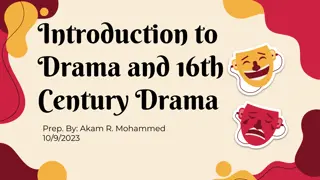Understanding Drama: The Art of Theater Expression
Drama, originating from the Greek word "Dran" meaning to act, is a form of storytelling performed in front of an audience. It differs from prose and poetry by providing a unique experiential aspect through live enactments. Essential elements such as playwrights, actors, acts, scenes, and dramatic speech contribute to the creation of a compelling narrative on stage. Conflict, stage directions, characterization, and the use of props and sets further enhance the dramatic experience. Theater serves as the setting for these performances, showcasing various types of dramas that explore serious subjects.
Download Presentation

Please find below an Image/Link to download the presentation.
The content on the website is provided AS IS for your information and personal use only. It may not be sold, licensed, or shared on other websites without obtaining consent from the author. Download presentation by click this link. If you encounter any issues during the download, it is possible that the publisher has removed the file from their server.
E N D
Presentation Transcript
The Elements of Drama Theater Arts
Essential Question How does drama provide the reader a different experience than prose (short stories, novels) or poetry? How is drama different from television?
Drama Comes from the Greek Word, Dran Means To do or To Act The Doing/Acting Makes Drama
Drama is a story told in front of an audience
Elements of Drama Playwright-the author of a play Actors-the people who perform Acts-the units of action Scenes-parts of the acts
Dramatic Speech Dialogue-conversation between or among characters Monologue-long speech by one single character (private thoughts)
Conflict The internal or external struggle between opposing forces, ideas, or interests that create dramatic tension.
Stage Directions Found in brackets [ ] Describe scenery and how characters speak C, Center Stage L, Stage Left R, Stage Right U, Upstage or Rear D, Downstage or Front
Theatre Where a play takes place
Set Construction on the stage that shows time/place Could be called Scenery
Props Small movable items that the actors use to make actions look real
Characterization Is the playwright s technique for creating believable characters. Indirect Direct
Types of Drama Drama is used to describe plays that address a serious subject.
Types of Drama Comedy is a form of drama that has a happy ending. Humor comes from the dialogue and situations.
Types of Drama Tragedy is a form of drama in which events lead to the downfall of the main character, often a person of great significance, like a king or hero.























